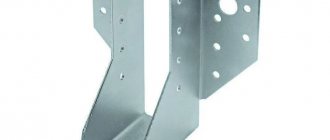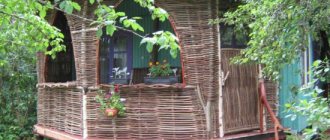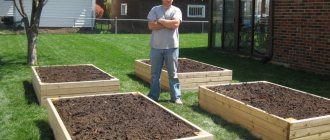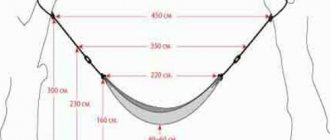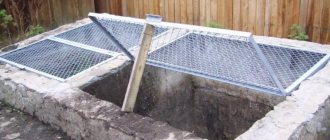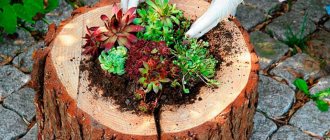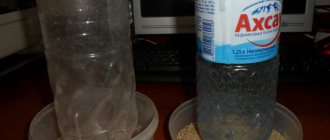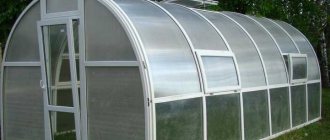Types of trellises and varieties of cucumbers for them
Supports for cucumbers can have different shapes and designs, both simple and fancy. Gardeners mostly make them with their own hands. Supports come in several basic forms:
- Frame made of posts and battens.
- Shape of a wigwam (hut).
- Round trellises in the form of an arch.
- In the shape of the letter "P".
Tall varieties are best suited for vertical cultivation:
- self-pollinating hybrids of the first generation: Maryina Roshcha, Three Tankmen, Chistye Prudy, Anyuta;
- early ripening: Real Colonel, Emelya, Mazai;
- Petrel - cucumbers with abundant branching;
- Ant, Okhotny Ryad, Cheetah - with moderate branching;
- class “Zozulya” with limited branching – Melnitsa, Marta.
Advantages of growing cucumbers on a trellis
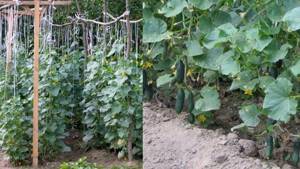
Supports can be installed both in the greenhouse and in the open ground. Perhaps the biggest benefit of growing cucumbers vertically is that they are easier to water at the base. You don’t have to pick through prickly leaves with your hands or dig through unruly thickets to find a free place for watering. In addition, this method will help stop the onslaught of fungal diseases. Weeding is also much easier.
A vertical trellis also makes harvesting cucumbers easier. Vegetables are easier to spot in thick green matter because they don't mix with dirt and leaves on the ground. The trellis makes it easier to maneuver around thorny stems that can scratch your hands and arms. The correct trellis will protect the overall integrity of the cucumber. Because the vegetable's contact with dirt is minimized, the harvest will be cleaner, straighter, and more uniform in color compared to cucumbers grown on the ground.
Prevention from insects and diseases
To prevent our crops from being disturbed by such eternal enemies as aphids, mites, powdery mildew or rot, it is necessary:
- do not plant cucumbers in the same place year after year;
- It is advisable to water with warm water;
- in the fall, after harvesting, treat the sown area with a weak solution of copper sulfate, potassium permanganate or other means that disinfect the soil well;
- spray the bushes with products effective against pests. Solutions based on laundry soap and baking soda perform well.
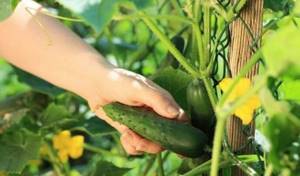
There is nothing easier than harvesting from vertical beds. Often you don’t even have to bend over. And the arched structure, entwined with cucumber shoots, will also add aesthetics to the overall garden landscape. And as it turned out, making trellises for cucumbers is absolutely not difficult, as they say, if only you had the time and desire...
In the video below you can see how to tie cucumbers in open ground
How to grow cucumbers on a trellis
The trellis for cucumbers should be strong, and the height of any trellis should be about one and a half meters. This is the approximate height of the vine when it reaches maturity. Cucumber trellises are easy to make yourself. The trellis should be placed in a permanent place when the seedlings reach 10-12 cm in height.
Attention!
The plant should be guided along the trellis when the fifth leaf appears. If you attach an adult fruiting cane to a support, fruiting will most likely stop.
Fasten the bottom of the support securely into the soil at a distance of 10 cm from the plant stem so as not to disturb the roots. Cucumber vine produces long tendrils that should wrap around the trellis as the vine grows. The antennae are very fragile, so be careful when handling them.
Features of growing on trellises in a greenhouse and in open ground
Growing cucumbers on a trellis in a greenhouse is similar to agricultural technology in open ground, only the distance between plants in a row in a greenhouse is 40 cm, and between rows is 60 cm. Since cucumbers come in different branching patterns, this fact must be taken into account. Slightly branched varieties are planted at a distance of 15-20 cm from each other, highly branched ones - about 25 cm. In central Russia, seeds can be sown in open ground no earlier than the beginning of summer, therefore, it is advisable to grow seedlings at home. After planting in the soil, cover the young shoots with film or agrofibre so that they do not freeze at low night temperatures, which can last until mid-June.
Information!
Water plantings in open ground in the evening, when the danger of sunburn subsides. In the greenhouse, the cucumbers are irrigated in the morning so that the evaporation of moisture rising from the warm earth creates the necessary comfortable microclimate. The water temperature should be at least 25 degrees.
Cucumbers grow very well in a polycarbonate greenhouse; they can be sown directly into the ground in mid-spring, so they will produce an early harvest. Trellis for indoor spaces differ from structures for open ground. Usually these are just stretched ropes running from the garden bed to the ceiling.
Garter vine
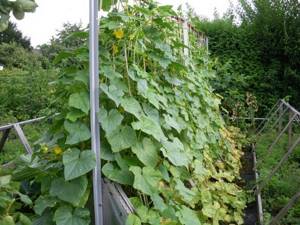
It is very important to tie the lashes to the trellis correctly. Without a garter, the vine will not be able to rise to a great height; the tendrils simply will not withstand the weight of the lash and fruits. In addition, wind and rain can tear off the tendrils and the plant will collapse. For a garter, a synthetic rope or other material is suitable, the main thing is that it meets the following requirements:
- was elastic;
- did not absorb water;
- did not damage the vine.
Staking can begin when the plants reach approximately 30 cm in height. You need to make a free slip knot under the bottommost sheet. Be sure to leave free space between the rope and the stem, because the latter will grow and thicken. The stem is fixed to the support in several conveniently located places; the nodes are always made under the rosette of leaves, that is, in the strongest places of the vine. When the bush reaches the top of the support, it is also tied to it.
Forming a bush on a trellis
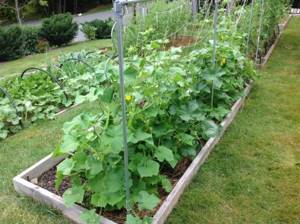
The process of forming a cucumber vine on a structure consists of the following steps:
- Pinching the “stepchildren” (shoots in the axils between the leaf and the stem) of the lower 4 leaves. Higher growing shoots on the 5th and 6th leaves are not removed, but only pinched, maintaining 15-20 cm of branches.
- Even higher up the stem, stepsons are formed 30 cm long, the tops are pinched.
- At the end of the lash, the side shoots are left long, about 50 cm.
- The main lash is thrown over the top of the structure and the top is pinched.
Trellis for growing cucumbers in open ground can be of different designs; their shape is limited by the gardener’s imagination and the materials he has.
How to make a trellis for cucumbers with your own hands
Let's look at how to make a comfortable support for cucumbers with your own hands. Typically, summer residents rely on available materials and their own construction skills.
See also
Description and characteristics of the Othello cucumber variety, planting and care
Read
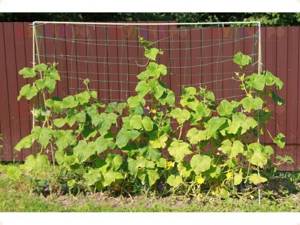
Simple rectangular
The basis of this design is timber up to 3 meters long. The usual height of the structure is 2 meters, which is exactly how tall the stems of cucumbers grow. Preparing the frame:
- Corner supports are made from bars with a diameter of 50 millimeters, deepening them into the soil by 70-80 centimeters. The length of the bed and the distance between the corner supports is 5 meters.
- To prevent the structure from collapsing under the weight of the lashes, the corner posts are reinforced with guy wires.
- The intermediate columns are deepened by 50-60 centimeters, their thickness is less - 40 millimeters.
- After installing the frame, it is important to correctly tension the wire - 2 millimeters thick, the first row at a height of 20 centimeters, the next after 30-40 centimeters.
The top wire is thicker - at least 3 millimeters, since it is this wire that will hold most of the weight when the cucumbers begin to weave and sing.
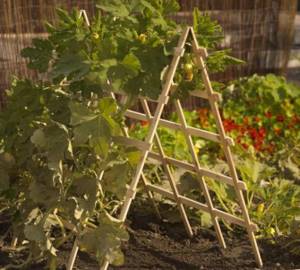
Important: wooden structural elements for cucumbers must be treated with drying oil and fungicides to increase service life and protect against fungi.
From lumber
With a sufficient amount of high-quality lumber, you can make a beautiful lattice that will securely hold the vines and make it easier to grow cucumbers in open ground.
The work flow is as follows:
- Corner supports are dug in (the thickness of the timber is 50 millimeters, the depth is 70-80 centimeters). Strengthened with wire anchors.
- After 1-2 meters, additional racks are made, with a smaller diameter.
- A cross member is laid on top between the corner supports and secured rigidly, so the grill slats will be attached to it. If desired, you can make a drawing to immediately cut out the slats of the required size.
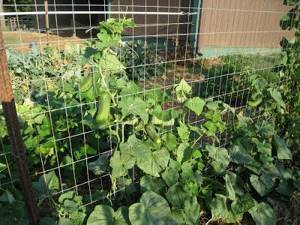
The size of the grid cells is 15 centimeters, the sufficient width of the slats is 3 millimeters. Such a pergola for cucumbers, with good woodworking skills, can become a decoration for your dacha.
From a metal profile
Metal structures are more durable; if fastened well, they will last a long time for gartering cucumber stems. The basis is made up of reinforcing bars more than 2 meters long. They are driven into the ground along the edges of the bed.
The easiest way to attach the top cross member from a pipe is to weld it with a welding machine. If this is not possible, twist the edges with wire or a thick cable. In this case, the frame will not be too reliable.
Between the supports, metal stakes are driven into the ground, to which the wire mesh will be attached. The pegs should be installed at a distance of 15 centimeters from each other. Wire is attached to the top pipe, side supports and stakes so that the cells are 15-20 centimeters in size.
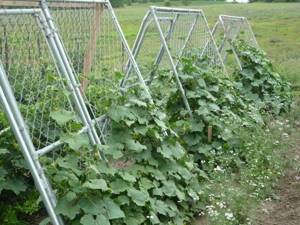
Tip: all metal parts are painted and treated with anti-corrosion agents.
From the tire
A cucumber trellis, made with your own hands from scrap materials (tires and wheels), turns out to be small and convenient. A large diameter tire is cut lengthwise, laid on the ground, the middle for a bed of cucumbers and the tire is covered with prepared soil. A metal reinforcement is inserted into the center, onto which the wheel rim will be attached.
The bicycle wheel is freed from the tire and spokes, only the rim is used. It is attached to the top of the reinforcement with wire.
The ground is covered with burlap, in the slots of which cucumber seedlings are planted. When cold weather is possible, agrofibre is used for shelter. The wire is pulled through the holes for the spokes and the tire.
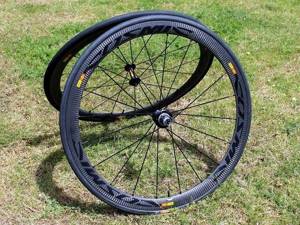
When the cucumbers entwine the device, it becomes like a canopy or hut with a round top. Such growing stands are mobile; next year they can be moved to another place, beautifully decorating the area.
See also
Description of Alex F1 cucumbers and do-it-yourself hybrid breeding
Read
From a special mesh
To create supports for cucumbers, several types of meshes are used:
- trellis;
- plastic made of polycarbonate;
- metal.
Each type has its own characteristics in fastening and caring for the material, which can be read in the instructions.
Installation rules:
- install reliable supports along the edges - pipes (metal or plastic), wooden poles;
- make intermediate posts for additional rigidity;
- on top, strengthen the rail into a spacer with a mesh pre-strung on it for attaching cucumber lashes;
- The sides of the mesh are attached to the supports with wire or twine, stretching without sagging.
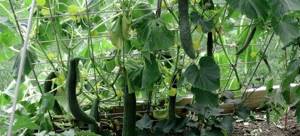
The side supports require stretching and significant deepening.
Ideas for trellises
There are many design options for reliable supports for cucumber vines, different in shape, material, and design. Some look purely utilitarian, designed only to clearly fulfill the assigned task, made from simple materials at hand. Others, along with the main function of supporting vines, also additionally decorate the garden. In simple terms, a support consists of support pillars dug into the ground and a mesh, ropes, or wooden slats stretched between them.
Old staircase
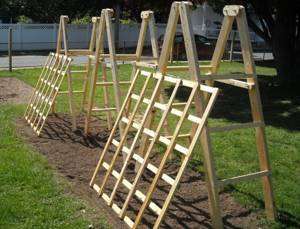
This idea is simple, easily implemented by any gardener; such a trellis for cucumbers is easy to make with your own hands. If you have an old wooden ladder that you no longer use, you can repurpose it into a cucumber trellis. Install the ladder at an angle to a wall or other support and secure it securely. To add some color to the structure, you can paint it to add charm to your garden while it busily holds your cucumber plants.
Rope hemp ladder
This is a budget option for trellises. Looks like a rope ladder suspended from the wall. It looks completely natural and authentic. Instead of hemp cord, you can use twine. Make such a trellis and hang it on the wall of your country house. This looks great and supports the cucumbers well too.
Rim trellis
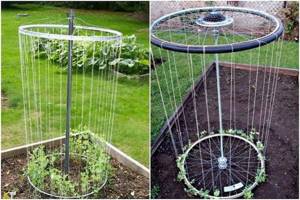
The structure is made from two wheel rims from old bicycles. A central pillar 1.5-2 meters high is installed in the ground. A rim is strung on it and secured 10-15 cm from the ground on small supports. On top, at the level of the top of the pillar, a second rim is attached. Both circles are connected to each other with ropes or twine at frequent intervals. Cucumbers are planted on the outer side of the structure, then the vines are directed up the ropes.
Lattice
There are many different ways to build trellises for climbing vegetables. The lattice is a very good option. A wooden or plastic grate is best. The latter will last longer and look better, but plastic is a slippery material, which can make it difficult for the vines to grip the trellis and rise properly. This is a very simple, inexpensive trellis that will hold your cucumbers. They grow and bear fruit throughout the season. The trellis can be used several times as it should last at least three to four seasons.
Wire mesh trellis
The wire mesh is strong, reliable, durable, and can properly support cucumbers. First you need to build a free-standing frame in the shape of the letter "U", then fill the open space with wire mesh with cells.
Trellis wigwam
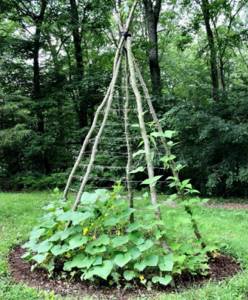
Cone-shaped design. You need large, strong sticks to form a wigwam. Use twine to tie the sticks together in several places. You can wrap the rope around the wigwam, lifting it up. Plant cucumbers at the base of the structure; they will gradually cover the wigwam.
Pallet trellises
This trellis is cost effective and functional. You can ask for pallets made from slats in grocery stores and small businesses. You need to make a structure by placing the pallets on the ends and fastening them at the top. The result will be a building similar to a hut. Plant cucumbers on both outer sides; they will tend to climb up the sloping sides of the trays.
Features of the garter
Cucumber is a climbing plant by nature. If the cucumbers are not tied up, then in the absence of support they will begin to creep along the ground.
There are various ways of gartering. With all the variety of designs, there is a main and inviolable rule. The garter must be soft. This is due to the fact that the cucumber stem is very delicate. The garter should not be too tight, but not too loose.
ATTENTION!!!
When tying cucumbers, it is not advisable to use ropes made of synthetic materials. Ribbons made of soft fabric two to two and a half centimeters wide are best suited.
How to build a cucumber arch
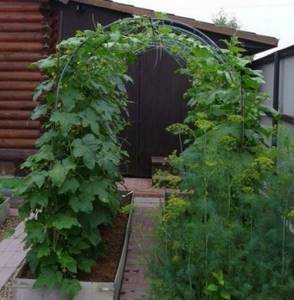
An arched trellis is perhaps the most beautiful and romantic. It will add charm to the garden and is not very difficult to build. Required tools and materials:
- metal mesh used for garden fencing;
- pillars - 4 pcs.;
- hammer;
- plastic wires for connecting the mesh to the posts;
- wire cutters;
- roulette.
Arch in 3 steps
Step 1. Measure and cut the mesh to fit the width of the arch. Use wire cutters for cutting. You can make the fencing sections shorter or longer depending on your preferred cucumber trellis height, but not too tall or you'll need center support for the structure.
Step 2: Drive the posts into the ground: You will have two posts at each end of the arch. Start by driving two stakes into one end of the arch.
Step 3: Attach the mesh to the posts.
Sowing cucumber seeds for the arch
When growing cucumbers vertically, you may want to space the plants a little closer together than recommended. It is also permissible to plant them inside and outside the arch. It doesn't matter, they will weave into the arch anyway. To fill the support evenly, plant cucumbers at both ends. They will grow along the sides of the lattice and meet somewhere in the middle of the arch. It's okay if the vines intertwine, it will just make your arch look fuller.
Trellis for cucumbers: its purpose
High yields of cucumbers are achieved not only by good care of this crop. To double the yield from your cucumber garden, just remember that the vine needs support. It is optimal for both the summer resident and the cucumber to place the plants on special trellises.
Stationary or portable structures support cucumber vines, provide optimal lighting and ventilation, and help shape the cucumber vine for maximum fruiting.
- The trellis supports the cucumber vines vertically, which protects the plant from damage by rot and pests, such as slugs.
- Due to the optimal conditions for the existence of the plant, an increase in yield up to 100% is achieved.
- The fruiting period is extended due to the competent focus of the cucumber vine on rejuvenation.
- The bed works more efficiently.
Trellis with cucumber vines look decorative - such a bed can successfully replace a hedge or a fence between areas.
Pros and cons of the method
There are 2 technologies for growing cucumbers: spread on a bed and on a trellis. The agricultural technique of harvesting greens on supports has clear advantages.
- The entire cucumber vine is evenly illuminated by sunlight, which ensures an increased sugar content in young fruits (optimal conditions for photosynthesis).
- Moisture does not stay on the green part of the plant for a long time - cucumbers almost do not suffer from fungal diseases (downy mildew and powdery mildew).
- When watering and fertilizing, the moisture dries quickly - the plant does not suffer dangerous sunburn.
- The vines are not damaged in the process of caring for the crop (cucumbers growing in a spread tree react very painfully to turning over the vines - they even lose color).
- It is much more convenient to care for the garden bed and harvest.
If the structure is placed correctly, there remains a row-spacing between the vertically tied vines - a passage up to 1 m wide. The summer resident moves freely with hand tools or a garden cart.
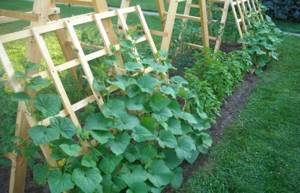
Cucumbers obtained on supports are always clean and spoil less during storage and transportation, and have a good presentation.
The trellis method of growing cucumbers requires more fertilizer and water. If this is a drawback, it is a very minor one. In terms of the area of the cucumber bed, growing on supports increases the yield and improves the quality of the fruit.
It is on trellises that the absorption of solar energy is most effective - not only do leaves and stems develop faster, but flowering also begins earlier.
When there is a lack of light, male flowers predominate. Good illumination leads to the superiority of female buds - the plant’s productivity increases significantly.
Gardener mistakes
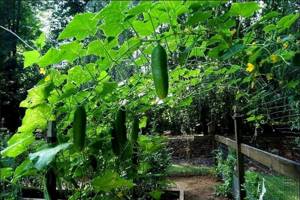
Trellis cucumbers do not always and not all gardeners delight with excellent harvests and beautiful vines. It happens that the lashes dry out or the ovaries fall off. This may be due to errors in agricultural technology:
- Cucumbers are always planted in one place - where a permanent trellis for cucumbers has been installed. Crop rotation is disrupted and plants begin to get sick. The soil must be free from cucumbers for at least 2 years, so it is better to make the structures easily dismountable.
- Incorrect site chosen for cucumbers. A shady place with drafts is absolutely not suitable. The culture loves sunny, windless areas.
- You need to be careful when choosing material to support cucumbers. For example, metal will not work - it gets very hot in the sun and the whip will simply burn. In addition, daily temperature changes have a detrimental effect on the vine.
- Cucumbers also don’t like the sun. Watering during a bright day is especially dangerous. Drops of water on the leaves under the rays of the sun turn into lenses, causing severe burns. It would be ideal to stretch a canopy of non-woven material over the structure, casting a light shadow over the entire structure, or a film material. Then the plant will not constantly get wet if there is a rainy summer.
Pros and cons of cucumber trellises
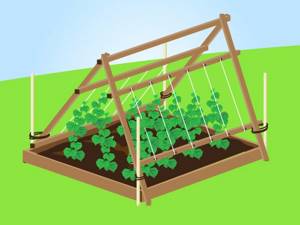
The development of plant mass of cucumbers occurs due to the formation of long shoots. Without support, the latter will simply crawl along the ground. Cucumber lashes need support and reliable fixation. To do this, vertical guides (supports) are formed around which shoots will curl or cling with tendrils. Trellis cultivation has a number of positive aspects:
- uniform distribution of sunlight and heat;
- good ventilation, access to fresh air to the shoots;
- rational watering of the plant - moisture goes directly to the root, and does not linger on the leaves;
- improving the taste of fruits;
Also, when harvesting, you do not need to turn over the leaves of the plant to look for fruits. The thorny shoots will not scratch your hands, and the lashes will not intertwine, twist or break. Among the disadvantages of using the trellis growing method are:
- Initial labor and material costs for manufacturing the support structure.
- Periodic maintenance of beds. Cucumber lashes require tying to a trellis.
- Constant soil irrigation. The leaves of plants do not shade the ground, as a result, water evaporates more intensely.
For your information! It is advisable to mulch trellised cucumber beds to prevent excessive drying of the soil.

